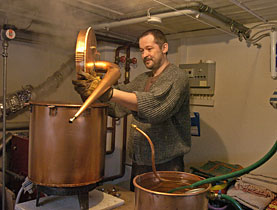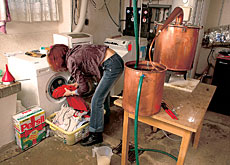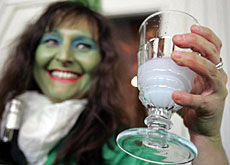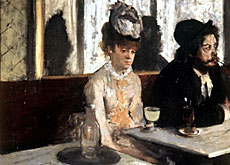Swiss “Green Fairy” seduces US tipplers

Swiss absinthe, the mythical liquor known to some as Green Fairy, has taken wing thanks to a surge in demand by drinkers in the United States.
Sales of the highly alcoholic spirit, legal in Switzerland since 2005, have quadrupled over the past six months. Around 40 per cent of absinthe is exported, with two-thirds going to the US, according to the Swiss Alcohol Board (SAB).
Exports of the beverage, reached 140,000 litres over the first six months of 2008 compared with 30,000 litres in the second half of 2007, according to SAB figures released last week.
Almost all domestic production flows from the historic heartland of the drink, the Val-de-Travers region in canton Neuchâtel, in the northwest of the country.
Absinthe was legalised in Switzerland in 2005 after having been forbidden for most of the 20th century over fears it caused hallucinations. The European Union has permitted the production of Pablo Picasso and Ernest Hemmingway’s favourite tipple since 1998 and the mythical spirit was unshackled from federal prohibition in the US in the spring of 2007.
Bans are now being lifted there on a state-by-state basis.
Although some had predicted the Green Fairy’s newfound legitimacy would detract from her allure, the rebirth of absinthe, especially in trendy US restaurants and bars, has proved critics wrong.
Sales have exploded Stateside, confirmed Marc Gilliéron, head of the SAB’s distillery operations for western Switzerland.
“The US market is a difficult one to break into; it’s hard to introduce a new product and get all the necessary authorisations, but once it opens up the demand is enormous,” he told swissinfo.
Orders for the herbal, anise-flavoured spirit are likely to continue to rise sharply over the next few years as states review their regulations, but it’s hard to say whether absinthe will be become a permanent fixture on the top shelves of US cocktail bars, says Gilliéron.
Success story
“It’s been a real success story,” Swiss distiller Yves Kübler told swissinfo. “We cannot cope with demand. Our annual capacity is currently limited at 250,000 litres, but we are tripling production capacity to more than one million litres a year by the end of 2009.”
Swiss absinthe’s renaissance is a triumph of marketing and of manoeuvring through a maze of US bureaucracy on formulas and labels.
Kübler, a Texas importer and a Washington lawyer, took four years to navigate the red tape to convince the US Food and Drug Administration to allow absinthe into the country. Approval for Swiss Absinthe Superieure Kübler, 106 proof, was finally granted on May 17.
To meet the strict US thujone standard [the toxic substance found in wormwood, absinthe’s main flavouring ingredient], brands must contain less than ten parts of the chemical per million. Swiss legislation allows for a “stronger” version – up to 35 parts per million – but as most commercial distillers want to crack the US market, they limit themselves to the US measure.
According to Kübler, students and a traditional “cocktail culture” have helped fuel the rise in the US.
With production capacity increasing, the ambitious company, which exports more than 70 per cent of its Fée Verte, is looking to expand beyond the US.
“We recently chose to turn down an offer in China as we didn’t have the capacity. You need at least 400-500,000 litres to enter that kind of market,” said Kübler. Distillers are look at other Asian markets and to Latin America.
Others confirm US demand for the pale, lime-green spirit, once a favourite of artists, writers and 19th century Parisian bohemians.
“My first order for the US will be delivered in September after a year of negotiations,” Claude-Alain Bugnon of Couvet, Val-de-Travers, told L’Express newspaper. “These 4,000 bottles represent a quarter of my annual production.”
Back home the Swiss absinthe market remains stable but stagnant, basically due to a lack of communication, says the industry.
Gone straight
Since 2005 and the renewed interest in Swiss absinthe, the SAB has handed out 17 licences to professional distillers, most of them to former bootleggers in the Val-de-Travers region. Their growing activity has also resulted in the creation of 20 jobs in the area.
According to Gilliéron, there are very few bootleggers left and they do not produce many bottles.
“I think in the Neuchâtel-Val-de-Travers region, where absinthe originated, there will always be bootleggers, as it’s a regional tradition, but the few left are people who distil absinthe for their own consumption or for their friends or family,” he said.
“The big illegal bootleggers went straight,” Kübler told swissinfo.
“I know the illegal industry really well, as I grew up in this region and made absinthe illegally when I was a student. Now there are only a few producing around 60 litres annually and about a dozen producing two or three litres from time to time. There is no real illegal market,” he said.
swissinfo, Simon Bradley
Legend has it that absinthe was invented in 1792 by a French doctor, Pierre Ordinaire, who settled in Couvet, a small village in western Switzerland.
The drink earned a reputation for being the tipple of choice of artists and writers, among them Ernest Hemingway, Pablo Picasso and Vincent Van Gogh.
Swiss voters, exasperated by what they saw to be widespread absinthe abuse, chose to ban it in 1908.
Absinthe survived in its heartland, the Val-de-Travers, where clandestine distillers continued to produce it over the years and local authorities turned a blind eye.
The ban on the sale and production of absinthe, which was introduced in Switzerland in 1908, was lifted on March 1, 2005.
New legislation also sets out under what conditions absinthe can now be produced.
In Switzerland legal absinthe must not contain more than 35 parts of thujone per million. In the US absinthe contain less than 10 parts. A bottle there costs around $50-60.
According to researchers for the British Medical Journal, absinthe bottled before 1900 packed up to 260 parts per million of thujone.

In compliance with the JTI standards
More: SWI swissinfo.ch certified by the Journalism Trust Initiative




You can find an overview of ongoing debates with our journalists here . Please join us!
If you want to start a conversation about a topic raised in this article or want to report factual errors, email us at english@swissinfo.ch.